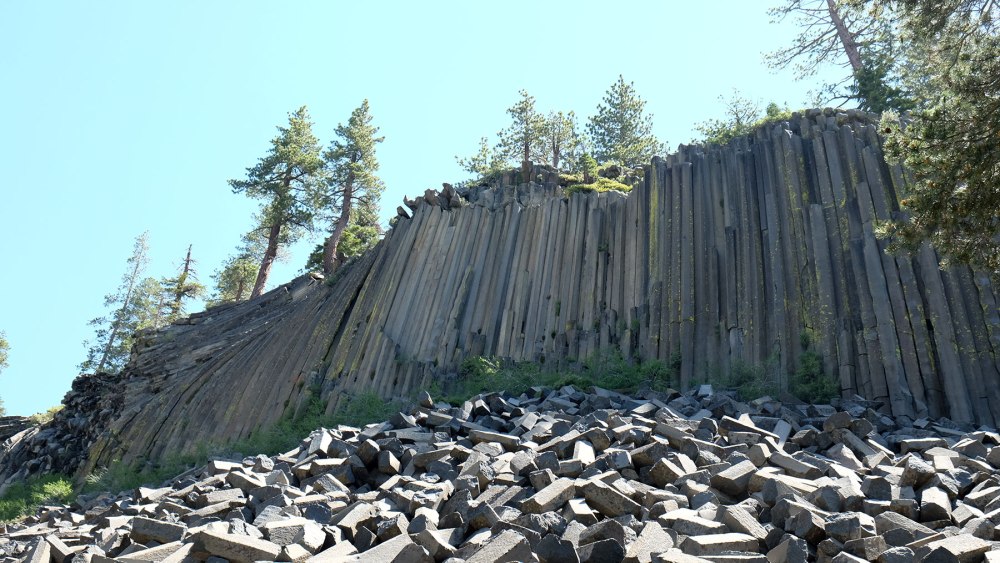Mammoth Lakes is a ski town in central California, approximately 300 miles north of Los Angeles. Although, well known for it’s winter sports, it has plenty of year round activities as well, including hiking, kayaking, fishing, and biking in the summer months! Mammoth is also full of strange and beautiful geographic phenomena created thousands of years ago by volcanic activity! Mammoth lies on the edge of the Long Valley Caldera. What’s a caldera? It is a geological feature formed by the collapse of a volcano into itself, creating a large volcanic crater. Mammoth Mountain was built by a series of approximately 25 separate eruptive episodes between 100,000 and 51,000 years ago, a blast 2,000 times greater than that of Mount Saint Helens! The area around Mammoth is geologically active, with hot springs and rhyolite domes that are less than 1000 years old. In my recent trip to Mammoth I explored Mono Lake, Devil’s Postpile, and Crowley Lake Columns. All three geographic features are unique to one another, but all were created from the same volcanic explosion that struck some 760,000 years ago!
Mono Lake

Located off Highway 395, 13 miles east of Yosemite National Park, Mono Lake is a shallow saline soda lake. Formed at least 760,000 years ago, the ancient lake has no outlet, creating high levels of salt to accumulate. The lake’s saline content is four times greater than that of the ocean! As a consequence of its high salinity, no fish live in Mono Lake, but there are plenty of brine shrimp that thrive in its waters, as well as migratory birds that settle on the nearby islands.
The unusual rock formations that line the lake are known as Tufas. The largest collection of them can be seen on the south end of Mono Lake. Tufa is essentially common limestone, but what is unusual about them is the way in which they are formed. These rock towers form when underwater springs rich in calcium mix with the waters of the lake, which are rich in carbonates. This mixture creates a chemical reaction resulting in the formation of limestone. Tufa towers grow exclusively underwater, but are visible now from the loss of water in the lake.
It’s an easy quarter mile walk down to the shore where the tallest Tufas are most visible. I enjoyed meandering around them on land while others chose to take a swim in the alkaline water. Some of the best time to view them is at sunrise and sunset, when an ambient orange glow illuminates the towers. Call them bizarre or beautiful, these Tufa towers have the likeness of ancient ruins long since passed.
Devil’s Postpile National Monument


Devil’s Postpile is a national monument established in 1911, an unusual rock formation of columnar basalt. The monument includes two main tourist attractions, Devil’s Postpile and Rainbow Falls. It’s an easy 6 mile trail roundtrip that you can complete in under three hours. The area is subject to heavy snowfall and is usually open only in the months of June-October. (It’s currently closed as of July 2017 from the high volume of snow to accumulate the area. No date set on when it will reopen, but hopefully soon!)
The large, and dark columns look oddly stacked, out of place, and too geometrical to possibly be formed naturally, but they are indeed organic! The were formed from lava flow some 100,000 years ago. Because of its great thickness, much of the mass of pooled lava cooled slowly and evenly, which is why the columns are so long and symmetrical. The columns average 2 feet in diameter. The dark grey color combined with the appearance of tall posts stacked in a pile give the feature it’s name. Some of the columns have different polygonal cross-sections due to variations in cooling. A survey of 400 of the Postpile’s columns found that 44.5% were 6-sided, 37.5% 5-sided, 9.5% 4-sided, 8.0% 7-sided, and 0.5% 3-sided.
Crowley Lake Columns


The Crowley Lake Columns is one of Mammoth Lake’s best kept secrets. These mysterious columns are only a 30 minute drive away from town, rising from the beach of Crowley lake. A little difficult to get to by land if you don’t have a 4WD vehicle. I approached the columns from the backside of Crowley Lake, following a very narrow, unmarked dirt road off of Benton Road. Fearing my vehicle might get stuck in the soft sand, I opted to hike the last mile or so down to the beach where the columns are located.
The even spacing and cylindrical shape resemble ancient Moorish temples. These strange columns were formed from the same volcanic eruption that created the Long Valley Caldera, 760,000 years ago when falling snow melted on top of the tuff rock deposits left after the eruption. The still-heated porous material caused the melted snow to boil, which created the even spaces between the columns that exist today. Estimates claim there are up to 5,000 of the columns within a 2- to 3-square-mile area to the east of Crowley Lake. These cement pillars appear in clusters of varying shapes and sizes. Some are gray and as straight as poles, while others are reddish-orange and bent, broken, or tilting. I believe there were even more columns around the corner, but the lake levels were too high for me to cross by foot. I have plans to return someday and take a kayak next time!












Wow, Jess I would have no idea these natural wonders were in Mammoth! I definitely need to check these out!
LikeLiked by 1 person